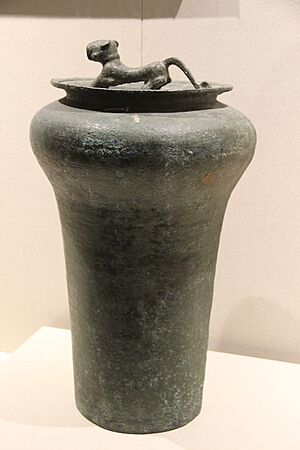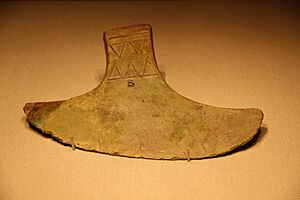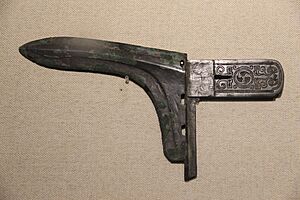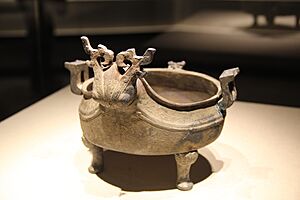Wu (state) facts for kids
Quick facts for kids
State of Wu
吳國
|
|||||||
|---|---|---|---|---|---|---|---|
| 12th century BC–473 BC | |||||||
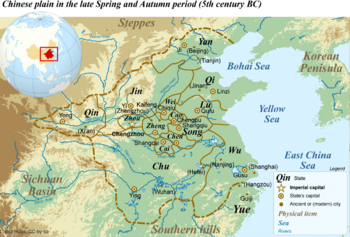 |
|||||||
| Status | Kingdom | ||||||
| Capital | Wu (modern-day Wuxi and Suzhou, Jiangsu province) | ||||||
| Government | Monarchy | ||||||
| Historical era | Zhou Dynasty Spring and Autumn period |
||||||
|
• Foundation by Taibo
|
12th century BC | ||||||
|
• Defeated by Yue
|
473 BC | ||||||
|
|||||||
| Wu | |||||||||||||||||||||||||||||||||||
|---|---|---|---|---|---|---|---|---|---|---|---|---|---|---|---|---|---|---|---|---|---|---|---|---|---|---|---|---|---|---|---|---|---|---|---|

"Wu" in seal script (top), Traditional (middle), and Simplified (bottom) Chinese characters
|
|||||||||||||||||||||||||||||||||||
| Traditional Chinese | 吳 | ||||||||||||||||||||||||||||||||||
| Simplified Chinese | 吴 | ||||||||||||||||||||||||||||||||||
|
|||||||||||||||||||||||||||||||||||
The State of Wu (Chinese: 吳; pinyin: Wú) was an important kingdom in ancient China. It existed during the Western Zhou dynasty and the Spring and Autumn period. Wu was located near the mouth of the Yangtze River. This area is east of the State of Chu and south of the State of Qi.
Wu had a few different capital cities over time. Its first capital was Meili, which is now part of Wuxi. Later, the capital moved to Helü's City, near Wuxi, and then to Gusu, likely in modern Suzhou.
Contents
History of the Wu Kingdom
How Wu Was Founded
An old story, first written down by Sima Qian in the Han dynasty, tells us about the start of the Wu royal family. It says their first leader was Taibo. He was a relative of King Wen of Zhou, who helped start the Zhou Dynasty.
Taibo was the oldest son of Gugong Danfu. His father wanted his youngest brother, Jili, to become the next leader of the Zhou family. To avoid any arguments, Taibo and his brother Zhongyong left their home. They traveled southeast to the area of Wu with people who supported them. They built their first capital at Meili, which is now Meicun in Wuxi. Jili, the youngest brother, later became the father of King Wen.
Wu Becomes Powerful
Not much is known about Wu's early history before the Spring and Autumn period. Wu started to become a strong state in the 6th century BC. This happened after the State of Jin helped Wu. Jin saw Wu as a useful friend against their enemy, the State of Chu.
In 584 BC, Wu went against Chu. A minister from Jin named Wuchen, who had left Chu, advised them to do this. From that time on, Wu was a constant challenge to the Chu Kingdom. Wu also encouraged other smaller states near the Yangtze River to rebel against Chu.
Wu Zixu was a very important person from Chu. His family members were harmed by King Ping of Chu. Wu Zixu then went to Wu, planning to get revenge. He became a trusted helper to Prince Guang. Wu Zixu even helped Prince Guang become king by taking over from his cousin, King Liao of Wu. After this, Prince Guang became known as King Helü of Wu.
In 506 BC, during the time of King Zhao of Chu, King Helü decided to attack Chu. King Helü led his army himself, along with his brother Fugai, Wu Zixu, and Sun Tzu. Sun Tzu is famous for writing The Art of War. Even though Chu had a strong army, Wu defeated them badly at the Battle of Boju. King Zhao of Chu had to run away. The Wu army captured Ying, which was Chu's capital city.
After these wins, Wu became the most powerful state for a short time. They then fought other battles, even defeating the State of Qi in 484 BC.
King Helü of Wu is seen as one of the most important leaders of China during the Spring and Autumn period. This is because of his military successes, helped by his famous general and planner, Sun Tzu. Wu is also thought to have created the first Chinese Navy. This navy was very advanced and had different types of ships.
The types of ships included:
- Great wing (da yi): Like heavy chariots on land.
- Little wing (xiao yi): Like light chariots.
- Stomach striker (tu wei): Like battering rams.
- Castle ship (lou chuan): Like mobile attack towers used in sieges.
- Bridge ship (qiao chuan): Like light cavalry.
These ships were described in an old book called Yuejueshu. It recorded a talk between King Helü and Wu Zixu. Wu Zixu said that naval forces should use land tactics for the best results.
The Fall of Wu
Later, Wu faced a threat from a rising state to its south called Yue. The State of Chu then helped Yue grow stronger to balance Wu's power. Wu won most of its battles against Yue and even captured Yue's King Goujian. However, Wu did not fully defeat Yue. This was partly because King Fuchai of Wu allowed King Goujian to live in Wu as his servant.
King Goujian suffered for years while serving Fuchai, but he planned his revenge. Fuchai, believing there was peace, let Goujian return to Yue. This turned out to be a big mistake for Wu. While Wu was fighting a war in the north, Goujian launched a surprise attack on Wu in 482 BC and took over its capital. Over the next ten years, Wu could not recover. Yue finally took over the entire state of Wu in 473 BC.
During the 6th century BC, Wu, Yue, and Chu all started calling their rulers "kings." This showed that the Zhou court's power was much weaker during the Spring and Autumn period.
Amazing Metalwork
Wu and Yue were very skilled at working with metals. They made excellent swords with special designs, patterns, and even gold or silver details. Swords from Wu and Yue often used more tin than copper compared to swords from other states. Wu often sent these special swords as gifts to northern states like Qi and Cai. Famous examples include the spearhead of King Fuchai of Wu and the sword of King Helu of Wu.
Kings of Wu Family Tree
Old Chinese history books connect the kings of Wu to Taibo, who was the uncle of King Wen of Zhou. Their family name was Ji. The last king of Wu, King Fuchai, had at least four sons. His chosen heir, You, was killed in battle. After Wu was defeated, Fuchai's other sons were sent away from the kingdom. They and their families later took "Wu" as their family name to honor their lost kingdom.
| State of Wu | |||||||||||||||||||||||||||||||||||||||||||||||||||||||||||||||||||||||||||||||||||||||||||||||||||||||||||||||||||||||||||||||||||||||||||||||||||||||||||||||||||||||||||||||||||||||||||||||||||||||||||||||||||||||||||||||||||||||||||||||||||||||||||||||||||||||||||||||||||||||||||||||||||||||||||||||||||||||||||||||||||||||||||||||||||||||||||||||||||||||||||||||||||||||||||||||||||||||||||||||||||||||||||||||||||||||||||||||||||||||||||||||||||||||||||||||||||||||||||||||||||||||||||||||||||||||||||||||||||||||||||||||||||||||||||||||||||||||||||||||||||||||||||||||||||||||||||||||||||||||||||||||||||||||||||||||||||||||||||||||||||||||||||||||||||||||||||||||||||||||||||||||||||||||||||||||||||||||||||||||||||||||||||||||||||||||||||||||||||||||||||||||||||||||||||||||||||||||||||||||||||||||||||||||||||||||||||||||||||||||||||||||||||||||||||||||||||||||||||||||||||||||||||||||||||||||||||||||||||||||||||||||||||||||||||||||||||||||||||||||||||||||||||||||||||||||||||||||||||||||
|---|---|---|---|---|---|---|---|---|---|---|---|---|---|---|---|---|---|---|---|---|---|---|---|---|---|---|---|---|---|---|---|---|---|---|---|---|---|---|---|---|---|---|---|---|---|---|---|---|---|---|---|---|---|---|---|---|---|---|---|---|---|---|---|---|---|---|---|---|---|---|---|---|---|---|---|---|---|---|---|---|---|---|---|---|---|---|---|---|---|---|---|---|---|---|---|---|---|---|---|---|---|---|---|---|---|---|---|---|---|---|---|---|---|---|---|---|---|---|---|---|---|---|---|---|---|---|---|---|---|---|---|---|---|---|---|---|---|---|---|---|---|---|---|---|---|---|---|---|---|---|---|---|---|---|---|---|---|---|---|---|---|---|---|---|---|---|---|---|---|---|---|---|---|---|---|---|---|---|---|---|---|---|---|---|---|---|---|---|---|---|---|---|---|---|---|---|---|---|---|---|---|---|---|---|---|---|---|---|---|---|---|---|---|---|---|---|---|---|---|---|---|---|---|---|---|---|---|---|---|---|---|---|---|---|---|---|---|---|---|---|---|---|---|---|---|---|---|---|---|---|---|---|---|---|---|---|---|---|---|---|---|---|---|---|---|---|---|---|---|---|---|---|---|---|---|---|---|---|---|---|---|---|---|---|---|---|---|---|---|---|---|---|---|---|---|---|---|---|---|---|---|---|---|---|---|---|---|---|---|---|---|---|---|---|---|---|---|---|---|---|---|---|---|---|---|---|---|---|---|---|---|---|---|---|---|---|---|---|---|---|---|---|---|---|---|---|---|---|---|---|---|---|---|---|---|---|---|---|---|---|---|---|---|---|---|---|---|---|---|---|---|---|---|---|---|---|---|---|---|---|---|---|---|---|---|---|---|---|---|---|---|---|---|---|---|---|---|---|---|---|---|---|---|---|---|---|---|---|---|---|---|---|---|---|---|---|---|---|---|---|---|---|---|---|---|---|---|---|---|---|---|---|---|---|---|---|---|---|---|---|---|---|---|---|---|---|---|---|---|---|---|---|---|---|---|---|---|---|---|---|---|---|---|---|---|---|---|---|---|---|---|---|---|---|---|---|---|---|---|---|---|---|---|---|---|---|---|---|---|---|---|---|---|---|---|---|---|---|---|---|---|---|---|---|---|---|---|---|---|---|---|---|---|---|---|---|---|---|---|---|---|---|---|---|---|---|---|---|---|---|---|---|---|---|---|---|---|---|---|---|---|---|---|---|---|---|---|---|---|---|---|---|---|---|---|---|---|---|---|---|---|---|---|---|---|---|---|---|---|---|---|---|---|---|---|---|---|---|---|---|---|---|---|---|---|---|---|---|---|---|---|---|---|---|---|---|---|---|---|---|---|---|---|---|---|---|---|---|---|---|---|---|---|---|---|---|---|---|---|---|---|---|---|---|---|---|---|---|---|---|---|---|---|---|---|---|---|---|---|---|---|---|---|---|---|---|---|---|---|---|---|---|---|---|---|---|---|---|---|---|---|---|---|---|---|---|---|---|---|---|---|---|---|---|---|---|---|---|---|---|---|---|---|---|---|---|---|---|---|---|---|---|---|---|---|---|---|---|---|---|---|---|---|---|---|---|---|---|---|---|---|---|---|---|---|---|---|---|---|---|---|---|---|---|---|---|---|---|---|---|---|---|---|---|---|---|---|---|---|---|---|---|---|---|---|---|---|---|---|---|---|---|---|---|---|---|---|---|---|---|---|---|---|---|---|---|---|---|---|---|---|---|---|---|---|---|---|---|---|---|---|---|---|---|---|---|---|---|---|---|---|---|---|---|---|---|---|---|---|---|---|---|---|---|---|---|---|---|---|---|---|---|---|---|---|---|---|---|---|---|---|---|---|---|---|---|---|---|---|---|---|---|---|---|---|---|---|---|---|---|---|---|---|---|---|---|---|---|---|---|---|---|---|---|---|---|---|---|---|---|---|---|---|---|---|---|---|---|---|---|---|---|---|---|---|---|---|---|---|---|---|---|---|---|---|---|---|---|---|---|---|---|---|---|---|---|---|---|---|---|---|---|---|---|---|---|---|---|---|---|---|---|---|---|---|---|---|---|---|---|---|---|---|---|---|---|---|---|---|---|---|---|---|---|---|---|---|---|---|---|---|---|---|---|---|---|---|---|---|---|---|---|---|---|---|---|---|---|---|---|---|---|---|---|---|---|---|---|---|---|---|---|---|---|---|---|---|---|---|---|---|---|---|---|---|---|---|---|---|---|---|---|---|---|---|---|---|---|---|
|
|||||||||||||||||||||||||||||||||||||||||||||||||||||||||||||||||||||||||||||||||||||||||||||||||||||||||||||||||||||||||||||||||||||||||||||||||||||||||||||||||||||||||||||||||||||||||||||||||||||||||||||||||||||||||||||||||||||||||||||||||||||||||||||||||||||||||||||||||||||||||||||||||||||||||||||||||||||||||||||||||||||||||||||||||||||||||||||||||||||||||||||||||||||||||||||||||||||||||||||||||||||||||||||||||||||||||||||||||||||||||||||||||||||||||||||||||||||||||||||||||||||||||||||||||||||||||||||||||||||||||||||||||||||||||||||||||||||||||||||||||||||||||||||||||||||||||||||||||||||||||||||||||||||||||||||||||||||||||||||||||||||||||||||||||||||||||||||||||||||||||||||||||||||||||||||||||||||||||||||||||||||||||||||||||||||||||||||||||||||||||||||||||||||||||||||||||||||||||||||||||||||||||||||||||||||||||||||||||||||||||||||||||||||||||||||||||||||||||||||||||||||||||||||||||||||||||||||||||||||||||||||||||||||||||||||||||||||||||||||||||||||||||||||||||||||||||||||||||||||||
Culture of Wu
The Records of the Grand Historian mentions that the people in Wu wore their hair short and had tattoos. For the historian Sima Qian, this showed they were different from the people in central China. In his time, Chinese people usually did not cut their hair or change their bodies. This was seen as disrespectful to their ancestors.
The rulers of Wu did not get special names after they died, which was common in other Chinese states.
Literature and Famous People
The famous military planner Sun Tzu, known for his book The Art of War, worked as a general for King Helü of Wu.
Language of Wu
Even though the rulers of Wu were said to be from the early Zhou family, the local language spoken in the Wu region was different from the Old Chinese spoken in central China. Historians have tried to connect this language to other language groups, but it's still a topic of study.
Legacy of Wu
The name "Wu" is still used today for the area around Suzhou and Shanghai. It's also used for the local way of speaking, called Wu Chinese. Other states and leaders in the region later used the name "Wu." This includes Eastern Wu during the Three Kingdoms period, and the states of Wu and Wuyue during the Ten Kingdoms period.
Connections with Japan
When Chinese ambassadors visited Japan much later, during the Wei and Jin dynasties, they wrote that the Wajin people of Japan claimed to be descendants of Taibo of Wu. Taibo is traditionally believed to be the legendary founder of Wu. Some experts think that the Yamato people and the Imperial House of Japan might be descendants of the Wu people, possibly even Taibo. Many Japanese historians also link the early Japanese Yayoi people to the Baiyue tribes, who lived in southern China.
Wu in Astronomy
In Chinese astronomy, Wu, along with Yue, is represented by the star Zeta Aquilae. This star is part of an area called Left Wall in the Heavenly Market enclosure (see Chinese constellations).
See also
- King of Wu
- Wu Zixu
- Yue


